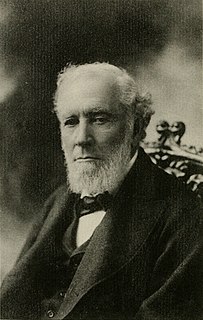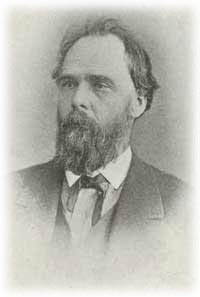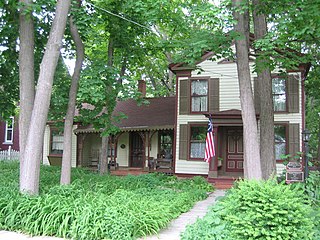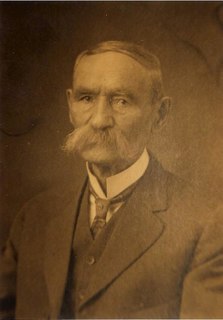
Plano is a city near Aurora in Kendall County, Illinois, United States, with a population of 11,847 as of the 2020 census. It is part of the Chicago metropolitan area, being about 55 miles from Chicago. The city was home to the Plano Harvester Company in the late 19th century, as well as the Plano Molding Company more recently. In 2011, downtown Plano was used as a set for Man of Steel.

John Deere is the brand name of Deere & Company, an American corporation that manufactures agricultural machinery, heavy equipment, forestry machinery, diesel engines, drivetrains used in heavy equipment, and lawn care equipment. In 2019, it was listed as 87th in the Fortune 500 America's ranking and was ranked 329th in the global ranking. The company also provides financial services and other related activities.

Graceland Cemetery is a large historic garden cemetery located in the north side community area of Uptown, in the city of Chicago, Illinois, United States. Established in 1860, its main entrance is at the intersection of Clark Street and Irving Park Road. Among the cemetery's 121 acres (49 ha) are the burial sites of several well-known Chicagoans.

The International Harvester Company was an American manufacturer of agricultural and construction equipment, automobiles, commercial trucks, lawn and garden products, household equipment, and more. It was formed from the 1902 merger of McCormick Harvesting Machine Company and Deering Harvester Company and three smaller manufactures: Milwaukee; Plano; and Warder, Bushnell, and Glessner. In the 1980s all divisions were sold off except for International Trucks, which changed its parent company name to Navistar International. Its brands included McCormick, Deering, and later McCormick-Deering, as well as International. Along with the Farmall and Cub Cadet tractors, International was also known for the Scout and Travelall vehicle nameplates.

William Deering was an American businessman and philanthropist. He inherited a woolen mill in Maine, but made his fortune in later life with the Deering Harvester Company.

The Case Corporation was a manufacturer of agricultural machinery and construction equipment. Founded, in 1842, by Jerome Increase Case as the J. I. Case Threshing Machine Company, it operated under that name for most of a century. For another 66 years it was the J. I. Case Company, and was often called simply Case. In the late 19th century, Case was one of America's largest builders of steam engines, producing self-propelled portable engines, traction engines and steam tractors. It was a major producer of threshing machines and other harvesting equipment. The company also produced various machinery for the U.S. military. In the 20th century, Case was among the ten largest builders of farm tractors for many years. In the 1950s its construction equipment line became its primary focus, with agricultural business second.

James Deering was an American executive in the management of his family's Deering Harvester Company and later International Harvester, as well as a socialite and an antiquities collector. He built his landmark Vizcaya estate, where he was an early 20th-century resident on Biscayne Bay in the present day Coconut Grove district of Miami, Florida. Begun in 1910, with architecture and gardens in a Mediterranean Revival style, Vizcaya was his passionate endeavor with artist Paul Chalfin, and his winter home from 1916 to his death in 1925.

The Cyrus McCormick Farm and Workshop is on the family farm of inventor Cyrus Hall McCormick known as Walnut Grove. Cyrus Hall McCormick improved and patented the mechanical reaper, which eventually led to the creation of the combine harvester. The farm is near Steele's Tavern and Raphine, close to the northern border of Rockbridge and Augusta counties in the U.S. state of Virginia, and is currently a museum run by the Virginia Agricultural Experimental Station of Virginia Tech. The museum has free admission and covers 5 acres (2.0 ha) of the initial 532-acre (215.3 ha) farm.

The Avery Company, founded by Robert Hanneman Avery, was an American farm tractor manufacturer famed for its undermounted engine which resembled a railroad engine more than a conventional farm steam engine. Avery founded the farm implement business after the Civil War. His company built a large line of products, including steam engines, beginning in 1891. The company started with a return flue design and later adapted the undermount style, including a bulldog design on the smokebox door. Their design was well received by farmers in central Illinois. They expanded their market nationwide and overseas until the 1920s, when they failed to innovate and the company faltered. They manufactured trucks for a period of time, and then automobiles. until they finally succumbed to an agricultural crisis and the Depression.

Plano station, also known as the Chicago, Burlington and Quincy Railroad Depot is an Amtrak intercity train station in Plano, Illinois, United States. The station was added to the U.S. National Register of Historic Places on November 12, 1993.

Lewis Steward was a U.S. Representative from Illinois. He also co-founded Marsh, Steward & Company, a company that later merged to become International Harvester.

The Lampert-Wildflower House is a home in the U.S. city of Belvidere, Boone County, Illinois. The main, upright, portion of the house was constructed in 1838 and the wing section was added to the home during the 1860s. It passed through the hands of several owners until it was purchased by Phillip C. Lampert who is responsible for the wildflower covered lawn. The property contains five types of rare plants and is semi-wooded, shaded by 32 trees. The home is a distinct example of Upright and Wing construction, though it retains some elements of the Greek Revival style it was originally designed in. The wing section of the house features a front porch decorated with Gothic Revival and Queen Anne style elements. The house was listed on the U.S. National Register of Historic Places for its architectural significance in 2005.

The Plano Stone Church was constructed in 1868 to serve as the headquarters for the Reorganized Church of Jesus Christ of Latter Day Saints under the leadership of Joseph Smith III. Smith moved to Plano, Illinois, in 1866 and in 1867 was appointed head of the Stone Church's building committee. Smith and the committee selected the site, design and builder for the structure. The Plano Stone Church served as the headquarters of the RLDS from its completion in 1868 until Smith, his family, and the church moved to Lamoni, Iowa, in 1881.

The Dundee Township Historic District is a set of sixty-five buildings in Dundee Township, Kane County Illinois. Buildings in the district are found in East Dundee, West Dundee, and Carpentersville. The district represents the development of the upper Fox River Valley from 1870 to the 1920s. Dundee Township became an important industrial area, especially following the construction of the Dundee Brick Company in West Dundee and the Illinois Iron and Bolt Company in Carpentersville. Also included in the district are a variety of Queen Anne, Italianate, and Greek Revival style houses and Gothic Revival churches. The majority of the historic district lies within the boundaries of West Dundee. It was added to the National Register of Historic Places in 1975.

Warder Public Library is a historically significant building in Springfield, Ohio, United States. A robust example of Richardsonian Romanesque architecture, it was a gift to the city from industrialist Benjamin H. Warder, and served as the main branch of the Clark County Public Library from 1890 to 1989. It now houses the Clark County (Warder) Literacy Center.

The Lewis Steward House is a historic residence in Plano, Illinois. It was the home of Lewis Steward, a prominent early settler to Kendall County who co-founded Marsh, Steward & Company, ran for the governorship of Illinois, and was elected to the United States House of Representatives.

The Hunter–Hattenburg House is a historic Queen Anne-style house in Kankakee, Illinois, United States. It was built for William R. Hunter, a prominent lawyer in Kankakee who had previously served as Kankakee City Attorney and would later serve on the 12th Illinois Circuit Court. In 1942, the house was purchased by Kankakee mayor Albert F. Hattenburg.

William Wallace Marsh was a Canadian American inventor and businessman who co-founded Marsh, Steward & Company with his brother Charles. Born in Ontario, Canada, Marsh developed an early harvester prototype on the family farm in DeKalb County, Illinois, United States. With help from businessman Lewis Steward, Marsh, Steward & Company became an early leader in harvester production. The company later merged with others to form International Harvester. Marsh lived in Sycamore, Illinois from 1873 until his death, serving as a longtime alderman.

David Richard Jones was a Welsh-American architect and poet.

The Elijah Thomas Webb Residence is a historic home in Webb City, Missouri. It was added to the National Register of Historic Places in 2020 as an "outstanding example of a high-style Queen Anne residence." The three-story building was built c. 1891 and has retained many of its original details. It is a rare surviving example of Queen Anne single-family architecture in Webb City. The residence was designed with an eclectic mixture of architectural features that include the Queen Anne, Italianate, Romanesque, and Eastlake movement details. The building has an irregular shape with a slate-clad hip roof with some lower gable sections and a polygonal tower on the front elevation. Red brick walls include contrasting bullnose corner bricks to create faux quoining on top a batter (walls) limestone foundation that extends five feet above grade. The most significant modification to the main building was the addition of a second-floor sleeping porch c. 1914.























